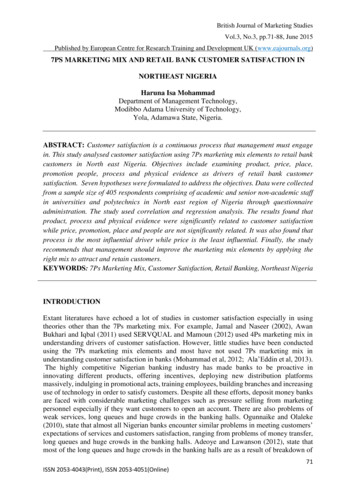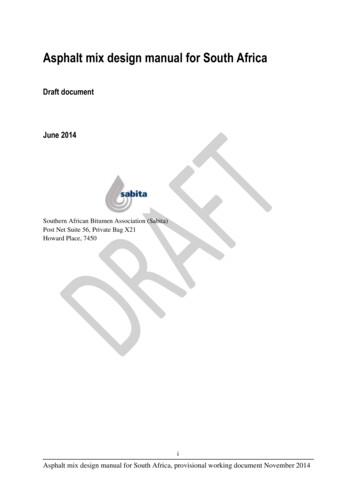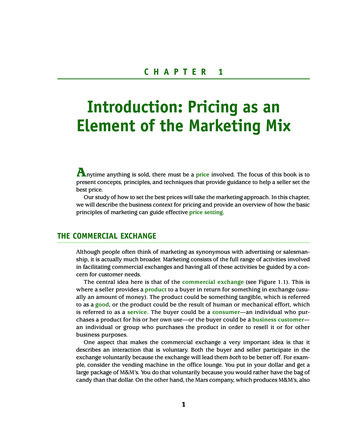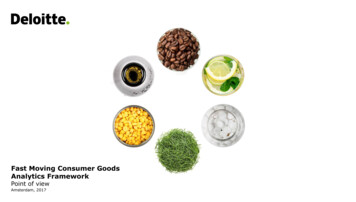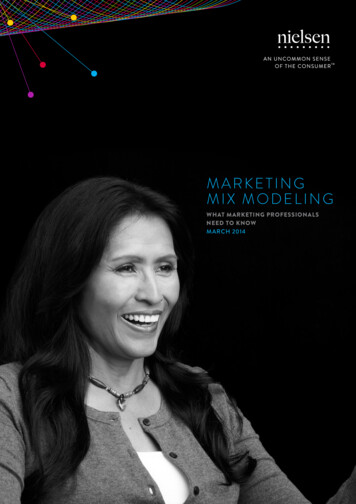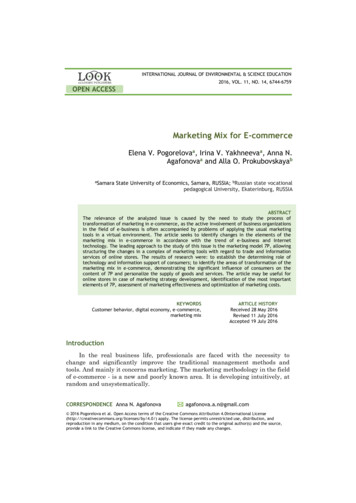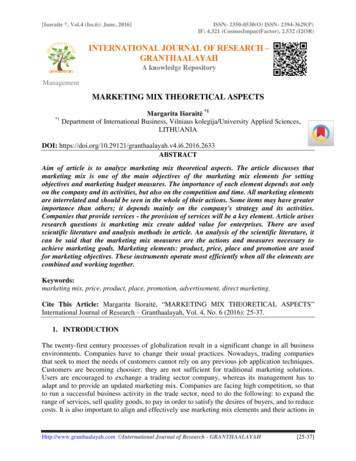
Transcription
[Isoraite *, Vol.4 (Iss.6): June, 2016]ISSN- 2350-0530(O) ISSN- 2394-3629(P)IF: 4.321 (CosmosImpactFactor), 2.532 (I2OR)ManagementMARKETING MIX THEORETICAL ASPECTS*1Margarita Išoraitė *1Department of International Business, Vilniaus kolegija/University Applied Sciences,LITHUANIADOI: 2633ABSTRACTAim of article is to analyze marketing mix theoretical aspects. The article discusses thatmarketing mix is one of the main objectives of the marketing mix elements for settingobjectives and marketing budget measures. The importance of each element depends not onlyon the company and its activities, but also on the competition and time. All marketing elementsare interrelated and should be seen in the whole of their actions. Some items may have greaterimportance than others; it depends mainly on the company's strategy and its activities.Companies that provide services - the provision of services will be a key element. Article arisesresearch questions is marketing mix create added value for enterprises. There are usedscientific literature and analysis methods in article. An analysis of the scientific literature, itcan be said that the marketing mix measures are the actions and measures necessary toachieve marketing goals. Marketing elements: product, price, place and promotion are usedfor marketing objectives. These instruments operate most efficiently when all the elements arecombined and working together.Keywords:marketing mix, price, product, place, promotion, advertisement, direct marketing.Cite This Article: Margarita Išoraitė, “MARKETING MIX THEORETICAL ASPECTS”International Journal of Research – Granthaalayah, Vol. 4, No. 6 (2016): 25-37.1. INTRODUCTIONThe twenty-first century processes of globalization result in a significant change in all businessenvironments. Companies have to change their usual practices. Nowadays, trading companiesthat seek to meet the needs of customers cannot rely on any previous job application techniques.Customers are becoming choosier; they are not sufficient for traditional marketing solutions.Users are encouraged to exchange a trading sector company, whereas its management has toadapt and to provide an updated marketing mix. Companies are facing high competition, so thatto run a successful business activity in the trade sector, need to do the following: to expand therange of services, sell quality goods, to pay in order to satisfy the desires of buyers, and to reducecosts. It is also important to align and effectively use marketing mix elements and their actions inHttp://www.granthaalayah.com International Journal of Research - GRANTHAALAYAH[25-37]
[Isoraite *, Vol.4 (Iss.6): June, 2016]ISSN- 2350-0530(O) ISSN- 2394-3629(P)IF: 4.321 (CosmosImpactFactor), 2.532 (I2OR)order to achieve effectiveness. Effective marketing mix management enables marketers to createa combination of elements that will enable wisely manage the company's budget in order toachieve the desired objectives. Companies that strive to operate effectively and achieve theirgoals have to pay well to control all elements of the marketing mix. In order to achieve the bestresult it is not enough to use only one or a few elements. The formation of the marketing mixelements requires taking into account the characteristics of each element so that they could bealigned. The non-alignment of the above-mentioned elements of interaction might be thecompany's shortcomings. Marketing mix analyzes authors like Pruskus (2015), Rad, Akbari(2014), Rahnama, Beiki (2013), Ria (2011), Sereikienė-Abromaitytė (2013), Singh (2012) andothers.2. THE CONCEPT OF MARKETING MIXMarketing mix means the product, distribution, promotion and pricing strategies to produce andcarry out exchanges and achieve the target markets. "Marketing mix - interrelated actions andsolutions to meet consumer needs and to achieve the company's marketing goals, a whole"(Sereikienė-Abromaitytė (2013)). "Marketing mix - a set of relevant factors and solutions thatenable customers to meet the (national) needs and achieve the goals set by the company (Pruskus(2015)). According to Singh (2016), marketing is a complex range of marketing mix solutionvariables used in the company seeking to sell their goods and services.Table 1: Definition of marketing mixDefinitionMarketing mix is originating from the single P (price) of microeconomic theory(Chong, 2003). McCarthy (1964) offered the “marketing mix”, often referred toas the “4Ps”, as a means of translating marketing planning into practice(Bennett, 1997). Marketing mix is not a scientific theory, but merely aconceptual framework that identifies the principal decision making managersmake in configuring their offerings to suit consumers’ needs. The tools can beused to develop both long-term strategies and short-term tactical programmes(Palmer, 2004).Riaz (2011)Marketing mix is defined as set of controllable marketing tools that a companyuses to create a desired response in the targeted market. (Set of these tools isgenerally referred to as 4P’s of Marketing, being Product, Price, Promotion andPlace.Rad, Akbari Marketing mix is a controllable part of marketing tools that affects the demand(2014)and increases it (Jonathan Ivy, 2008: 298). By the compound, mix, or acombination, it is meant that the four ps (product, price, promotion, place)should have an established and coordinated systematic approach in order tohave effective influence on persuading the customers. In other words, the rightproduct at affordable prices is accompanied by better distribution and use ofappropriate communication techniques and they act together in costumers'views.Singh (2012) Marketing mix is the combination of different marketing decision variablesbeing used by the firm to market its goods and services. After identifying themarket and gathering the basic information about it, the next step is theAuthorGoi (2009)Http://www.granthaalayah.com International Journal of Research - GRANTHAALAYAH[25-37]
[Isoraite *, Vol.4 (Iss.6): June, 2016]ISSN- 2350-0530(O) ISSN- 2394-3629(P)IF: 4.321 (CosmosImpactFactor), 2.532 (I2OR)direction of market programming, is to decide upon the instruments and thestrategy to meet the needs of the customers and the challenge of thecompetitors. It offers an optimum combination of all marketing ingredients sothat companies can realise goals for example profit, sales volume, marketshare, return on investment etc. The marketing mix is grouped under fourelements i.e., Product, Price, Place, Promotion.Therefore, while satisfying the needs of consumers, the company makes decisions related to theproduct, its price, distribution / place and promotion, and the four of the group is considered tobe the key marketing mix elements also called - "4P" marketing mix (see. Fig.1) (Gronholm(2012)).Design; technology;utility; valueconvenience; quality;packing; brand; guaranteesAdvertising; public relations;support; sales promotion;direct marketing; purchasepoint / location; exhibitionsand fairs; private sale; leaflets /posters; free gifts;Price list; discountsProductPricePromotionPlacecredit conditions;redemption period;promotionChannels; logistics;productinventory(balances / reserves);transport; the range;placeFigure 1: "4P" marketing mix elements (Gronholm (2012))These main marketing mix elements that work in isolation are supplemented by scientificliterature and some authors with these additional elements: people, process, and physicalevidence. In scientific literature this addition to the complex is called "7P marketing complex.The planning of marketing activities can be used in all the marketing mix elements.3. PRODUCTProduct is defined as a physical product or service to the consumer for which he is willing topay. It includes half of the material goods, such as furniture, clothing and grocery items andintangible products, such as services, which users buy (Singh (2016)).Dang (2015) emphasizes that the product is the first and one of the key marketing elements.Author cit. Kotler and Armstrong emphasizes that the product: "is what can be offered to themarket, to get attention, to be the acquisition of used or used, and can satisfy the wants or needs."In fact, it was observed that in most cases the literature is dominated by a narrow "product"concept of perception, so in order to better understand the nature of the product see Figure 2,which shows a wider perception.Http://www.granthaalayah.com International Journal of Research - GRANTHAALAYAH[25-37]
[Isoraite *, Vol.4 (Iss.6): June, 2016]NATURALPRODUCTSISSN- 2350-0530(O) ISSN- 2394-3629(P)IF: 4.321 (CosmosImpactFactor), 2.532 gure 2: Product wider perception (Strazdas (2011)Thus, the product concept is very broad and includes not only natural products and services, butalso the experience, people, places, property rights, businesses or organizations, information andideas.Uznienė (2011) emphasizes that all products on the market have a life cycle (PGC) - selling ofgoods or services, and making profit during its life time (see Fig. svolumesProfitnasTime0Figure 3: Product / service life cycle stageTherefore, it is divided into these PGC (product life cycle) phases (Uznienė (2011)):1) Product development, which begins when a business finds a new product idea and beginsto implement it, the sales revenue of which in the course of its development is zero, andinvestment costs are high;2) Placing on the market, the sales revenue begins to rise slowly, but it lacks profitability,because the product marketing costs are still high;3) Growth, during this period the market is encouraged by the product and the profits start torise;Http://www.granthaalayah.com International Journal of Research - GRANTHAALAYAH[25-37]
[Isoraite *, Vol.4 (Iss.6): June, 2016]ISSN- 2350-0530(O) ISSN- 2394-3629(P)IF: 4.321 (CosmosImpactFactor), 2.532 (I2OR)4) Maturity, in this period, sales revenue growth decreases, because the majority of potentialbuyers choose alternative products or due to the increasing marketing expenses in orderto protect the product from its competitors;5) Decline, the stage when sales revenues and profits begin to decrease.However, in order to further expand the product awareness, Thrush (2011) proposes to assessthese three points of view: Customer Satisfaction approach; The materiality of importance in terms of; The process and outcome perspective.Thus, the real benefits - the main reason why a consumer buys a product, which shows the basicbenefits of the product to the consumer. The main product - this is the minimum characteristicsof the product, which requires that the user can receive substantial benefits. The expectedproduct includes the following features of the product, which the user expects to get out of it, andthis covers the user's expectations. A supplemented by product - this is a product that surpassesthe expectations of the average user, and can be supplemented with new properties or theimproved existing ones. It depends on many factors: the chosen marketing strategy targetedsegment features competing product characteristics, product technical feasibility, the availableamount of resources, etc. The potential of the product can transcend not only the smallest butalso the largest expectations of a contemporary user and have properties, which may surprise theuser (Thrush (2011)).The products are also classified (Uznienė (2011)): Consumer product - it (toothpaste, bread, newspapers, clothes, household appliances, etc.The product they purchase for their personal use and these products are still divided intominimum, valuable, exclusive and unmarketable (not intended to search): Necessary product - a product that the consumer buys frequently and almost immediatelywithout comparing it to other products of the same type; Valuable product - more Consumer-oriented product, which the consumer usuallycompares to others, considers its suitability, the quality, price and style; Exclusive product - is Consumer product that has unique characteristics or isdistinguished by its brand, which is bought by a large group of customers; Transgressed (not intended to search) the product (blood donation, life insurance) Consumer is a product which a user does not know, and if he knows he has no intentionto buy it.Meanwhile, the product range covers all goods family, class types, brands and units, which theseller offers to the buyer. The range - it's the company’s goods group/whole offered to theconsumer, which are similar not only in their features, but are also grouped according to certaincharacteristics, and focused on the users' needs. Where the range width of products offerednumber of groups, and shows the depth of one product group in the number of goods. The rangecan be characterized on the basis of not only the depth (deep range), N (width), but alsoalignment and saturation.Http://www.granthaalayah.com International Journal of Research - GRANTHAALAYAH[25-37]
[Isoraite *, Vol.4 (Iss.6): June, 2016]ISSN- 2350-0530(O) ISSN- 2394-3629(P)IF: 4.321 (CosmosImpactFactor), 2.532 (I2OR)The analysis of the scientific literature revealed that the product is associated with the service.The same services as compared to the product / product have different characteristics, namely: Intangibility - intangible traits, which have many items, but the service can be consideredas a product only when this feature is dominated by the tactile qualities. As such, theresult - in addition to visual expression can customer awareness; Non-accumulation - in which many services are projected at the same time as granted andmust not be prepared in advance and stored. This raises labor allocation problems, suchas seasonality; Non-severability - since services production and consumption are closely related, so theycannot be separated and have no severed features. As such, it cannot tell the customerwhere there is none; Heterogeneity - this is when the service is nothing other than the service provider and therecipient interaction, which may be granted not to every user similarly, for example, atelevision program about the increased taxes can be understood by each individual andfocused on the perception about heavier tax burdens on others that helps assess thecountry's budget collection (Sereikienė-Abromaitytė (2013)).In summary, the product concept is very broad and includes not only natural products andservices, but also the experience, people, places, property rights, businesses or organizations,information and ideas. Perception through the user needs of the approach includes 5 productlevels: the real benefits, the main product, expected product, added to the product, the potentialof the product. Furthermore, the products are classified according to the objects of consumptionproducts, which is still divided into minimum, valuable, exclusive and unmarketable (notintended to search).4. PRICEPrice is one of the most important marketing mix items and many scientists consider the price asone of the most important elements of the market, which increases not only profits, but alsomarket share. However, the price is not only one of the key factors in a competitive situation,which directly affects the company's sales and profitability indicators, but also one of the mostflexible marketing mix elements, which can quickly adapt to environmental changes. Therefore,it is the price is perceived as the only element of the marketing mix, generating revenue and themost important customer satisfaction and loyalty factor.With respect to prices, as one of the marketing mix elements observed in the scientific literature,there are different rates of conceptions and interpretations of the definition, for example:The price includes a fair assessment of the product, e.g., a good price for a good product (Ehmke,Fulton, Lusk (2016)). Kotler and Armstrong, the price is defined as the amount of money to payfor a product or service, or the value of the exchange help customers receive a product or servicefor a certain amount. "Thus, the direct cost of the period is the amount of money the buyer has topay for the product or service that is likely to buy it. "The price may also be defined as amonetary expression of value for the consumer agrees to pay" (Entrepreneurship Academy(2012). The price is the amount that the consumer must pay, that would involve exchanges, sothe price of the product depends on the different elements of change. The price is the onlyHttp://www.granthaalayah.com International Journal of Research - GRANTHAALAYAH[25-37]
[Isoraite *, Vol.4 (Iss.6): June, 2016]ISSN- 2350-0530(O) ISSN- 2394-3629(P)IF: 4.321 (CosmosImpactFactor), 2.532 (I2OR)marketing element, on which income and all other elements are related to the cost. Thus, price isone of the factors affecting the consumer, because it helps him to understand the value of theproduct. Also, the price can be specified as an actual or valuable, giving value, and the price ofcompanies to identify their products or services in the role as the regulation of its marketability(Owomoyela, Olasunkanmi, Oyeniyi (2013)).Singh (2016) highlights that a very important factor in determining prices is influenced by thecost of the product, marketing strategy and costs associated with the distribution, advertisingcosts or price changes in the nature of the market.Pricing is dependent on volume of marketed production, so there is always an inverserelationship: the higher the price, the sales decline. Therefore, setting your product price can becomplicated and it is therefore possible to use the following measures: Cost-plus - are accompanied by a standard percentage of profits to the future costs tomanufacture the product, e.g., the evaluation of the fixed and variable costs; Value basis - some are based on the buyer's perception of value (rather than its cost).Here, the buyer's perception depends on all aspects of the product, including the price offactors such as the quality of the image and prestige; The competition - which relies on other companies competing products prices. Here, thecompany's prices compare the prices of their competitors and thus can directly monitortheir competitors and price response to changes occurring in the market. Becauseotherwise, customers can select other vendors on the basis of proposals submitted; Input Size - When entering a market is established a joint product price. Then, mostcompanies have to cut down or too not to increase prices in order to keep control of themarket; Discount - which is based on advertising, helps reduce prices and thus can attract newcustomers and expand the market share; Unprofitable guide - which is based on the assumption that the sale takes place at a pricelower than the cost of production in order to attract customers to the store to buy otherproducts; Psychological - which has an impact on consumer behaviour, such as a price that looksbetter: 4.99 per pound instead of 5.00 per pound.In summary, it can be said that the price is one of the factors affecting the consumer, because ithelps him to understand the value of the product. Therefore, the cost should include thefollowing in terms of money that will give value for the consumer willing to pay. Price is theonly element of the marketing for the income and all other elements are related to the cost. Itslevel depends on the volume of marketed production, so there is always an inverse relationship:the higher the price, the sales decline.5. PLACEAnother very important element of marketing is a place that is also called the distribution, whichis defined as the process and methods by which products or services reach customers (by Martin(2014)).Http://www.granthaalayah.com International Journal of Research - GRANTHAALAYAH[25-37]
[Isoraite *, Vol.4 (Iss.6): June, 2016]ISSN- 2350-0530(O) ISSN- 2394-3629(P)IF: 4.321 (CosmosImpactFactor), 2.532 (I2OR)Uznienė (2011) states that "distribution - companies' products in the dissemination of measuresto ensure the identification and implementation. Distribution - that helps customers and users tofind and keep purchase those products from those manufacturers / providers with them at thetime of need. " "Distribution - this element of the marketing mix, which include decisions andactions related to the movement of goods from the producer to the consumer" (Matola (2009)).Thus, the distribution may become a functioning complex system where producers, brokers andindependent trade and the interests of consumers wholly compatible with each other in a certainenvironment and a certain time.Uznienė (2011) argues that marketing distribution function is twofold: Distribution perceived as a marketing channel, whose purpose - to make the servicebecome not only more accessible but also easier accessible to a friendly user; Physical distribution, which is attributed to local conditions, technical feasibility,transportation and other conditions, depending on the nature of the service.The distribution channel is defined as an integral part of the service, which involves the serviceprovider, intermediaries (agents) and the same service user (in most cases). Therefore, in order tocontrol and manage these processes, companies need to develop an appropriate marketingchannel, to coincide with the company's goals (Dang (2015)). Uznienė (2011) argues that for thecreation of the distribution chain, it is necessary to: analyze consumer needs; determine the distribution chain objectives and possible obstacles to achieve them; identify the key distribution chain alternatives; assess these alternatives.The analysis of the scientific literature revealed that there are different ways by which companiescan choose to provide products and services to customers. Among them are usually assigned twotypical distribution channels, the direct and indirect marketing channels (Dang 2015)).Thus, this channel directly from the producer provides a product or service to the consumer.Direct distribution of goods can take place in two forms, namely: through its own sales branchesand employees and through independent brokers who operate in accordance with the productioncompany's directions (through dealers, brokers (brokers), commissioner).Meanwhile, the indirect distribution channel includes brokers, in this regard; any producercompany sells its goods wholesalers, the retailer and as products reach consumers. This canincrease the cost of products, because each agent will receive a percentage of their profits.In summary, the distribution – it is marketing mix elements, which include decisions and actionsrelated to the movement of goods from producer to consumer. The distribution channel isdefined as an integral part of the service, which involves the service provider, intermediaries(agents) and the same service user (in most cases).Http://www.granthaalayah.com International Journal of Research - GRANTHAALAYAH[25-37]
[Isoraite *, Vol.4 (Iss.6): June, 2016]ISSN- 2350-0530(O) ISSN- 2394-3629(P)IF: 4.321 (CosmosImpactFactor), 2.532 (I2OR)6. PROMOTIONThe last 4P marketing complex element of the promotion, which helps to increase consumerawareness in terms of their products, leads to higher sales and helps to build brand loyalty. Thus,the promotion of the marketing mix is a tool that helps disseminate information, encourage thepurchase and affects the purchase decision process.Sponsorship is the most important consumer sales promotion tool that includes discounts andpromotions, as well as coupons, samples, refunds, bonuses, awards, contests and productdemonstrations, and to say what motivates consumers to buy. "Sponsorship - is an activity thatmakes the target customers aware of a product or service and their advantages and is convincingto buy the product (Kotler, Armstrong, Saunders, Wong). Sponsorship - this element of themarketing mix, covering decisions and actions provided for groups of people that are informedand encouraged to buy (Pranulis, Pajuodis, Urbonavicius, Virvilaitė (2012)). However, in orderto understand what is the promotion is, it is necessary to consider the complex elements providedin the scientific literature, such as advertising, sales promotion, personal selling, public relationsand direct marketing.Advertisement, The word banner is derived from the French Reclams (Lat. RECLAMA "screaming") and has two lexical meanings:1) it is the dissemination of information about goods (books, sanatoriums, excursions and soon.);2) it is an advertisement, poster, display, message through radio, television and so on.Advertising - by far the most widely used marketing tool, the core of which consists of apragmatic valuable social information associated with the advertising image and is focused onthe direct compelling or fascinating hidden, but a pragmatic directional communication with theaudience. Advertising is any form of information and the promotion of a set of ideas that helps toinform customers about new products and helps to reduce barriers between customers andorganizations (Rahnama, Baker (2013)).Sales promotion- Sales promotion is attributed to the actions and decisions which providespecific short-term measures, but to encourage the purchase, use, as well as by facilitating thepurchase of goods and can be directed to the end user or intermediary. This promotional toolused by a consumer or buyer provocation - to buy more and faster. Inducements includecoupons, prizes, free samples, discounts, promotional items, etc.Thus, sales practices may be directed to: User (samples, coupons, bonuses, prizes, guarantees); traders (including price reductions, promotional allowances and free products); corporate sales personnel (sales exhibitions, sales representatives contests and specialpromotion)Matola (2009) argues that, despite the measures to promote diversity, they can be grouped asfollows: organization of competitions between the dealers and the buyers, the awarding of prizes;Http://www.granthaalayah.com International Journal of Research - GRANTHAALAYAH[25-37]
[Isoraite *, Vol.4 (Iss.6): June, 2016] ISSN- 2350-0530(O) ISSN- 2394-3629(P)IF: 4.321 (CosmosImpactFactor), 2.532 (I2OR)product demonstration shelves;sending the samples free of charge;coupons guaranteeing price discount for buying a product, use;gifts buy other goods in the same company;discounts to wholesalers;selling price reduction.Sales incentives in store include: visual (score board in the store or screens are used not only asan advertising display products, but lotteries, contests the place and also - product layouts, boxeslotteries and the like.); product presentations and demonstrations - is a new delivery of goods inthe store, where customers not only discover but also to test the goods; games and sweepstakes,coupons - which aims to attract buyers through positive emotions), and discounts and rebates(the most common promotional tool, in which users are particularly interested. Meanwhile, salespromotion measures outside the shop at the store includes distributed coupons (mailboxes,newspapers or magazines, on the streets) and loyalty schemes (buyers events, customer cards,buyers clubs, excursions, etc.).Private sale- Private sale - it is a personal communication to convince a potential buyer topurchase the proposed product or service. This is the most expensive form of sponsorship,because it includes a contact with one person rather than with a broad audience, but this measuregenerally has a decisive influence on the buyer's decision. Private sale - it is the interactionbetween the buyer and seller.Marketing researchers such as Pajuodis, Albrechtas, and others identify the following keypersonal sales targets: to inform potential buyers of the supply; to establish and maintain the relationship with customers; to cause interest of buyers for their offers; to make the buyer positively assess the proposed goods and services; the need to awaken the hidden; to help customers solve problems; award the sale.The following basic types of private sales are discerned: retail sales (supermarkets, drugstoresand other shops); missionary sale (doctors, dispensing medications); retail sales (end-users);business-to-business sales (production, operations); professional selling (opinion leaders,sponsors).Public relations- Public relations involve communication between the organization and themanagement of society and affects behaviour. Public relations (PR), it is - to support thecomplex element that helps to maintain good relations with the public, and the contact points ofthe classrooms with a positive corporate image of the company, owned by unfavourablerumours, gossip and incidents.Dambrava (2013) distinguishes the following main objectives of RSV, which is necessary toimplement the sales: develop and enhance the credibility and acceptance of the organization;Http://www.granthaalayah.com International Journal of Research - GRANTHAALAYAH[25-37]
[Isoraite *, Vol.4 (Iss.6): June, 2016] ISSN- 2350-0530(O) ISSN- 2394-3629(P)IF: 4.321 (CosmosImpactFactor), 2.532 (I2OR)increasing public interest, taking into account the interests and needs;develop and maintain communication and cooperation with the public;gain understanding and approval of the organization's activities;organizations expressing interest, delivery and adjustment;operation of public opinion;conflict resolution and negotiation;consensus, harmony of creation.Matola (2009) emphasizes that communication with the public is important for both internal andexternal communications. Internal communications, spreading further affect the companyemployees' opinion about their firm and production, because each worker transmits theinformation for many people with whom he interacts. And, external public relations, helping toshape public opinion by
Marketing mix is a controllable part of marketing tools that affects the demand and increases it (Jonathan Ivy, 2008: 298). By the compound, mix, or a combination, it is meant that the four ps (product, price, promotion, place) should have an establ
